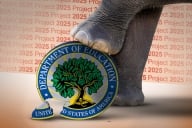You have /5 articles left.
Sign up for a free account or log in.

University of Maryland President Wallace Loh, UMD System Chancellor Brit Kirwan and Big Ten Commissioner Jim Delaney announce Maryland's switch to the Big Ten Conference in 2012.
Getty Images
ADELPHI, Md. -- William (Brit) Kirwan grew up in the world of competitive college athletics. His father was the University of Kentucky’s football coach and eventual president. Kirwan played tight end while attending Kentucky and majoring in mathematics.
But the world of college athletics has changed dramatically since Kirwan played football for Kentucky's flagship university. And the seasoned administrator says those changes aren’t good for universities or athletes.
Kirwan, 77, comes to the issue of college athletics from many angles. He spent the last 13 years as the chancellor of the University System of Maryland, retiring on June 30. He was president of Ohio State University for five years and served for a decade as president of the University of Maryland, where he spent the earlier part of his career as a faculty member and eventual administrator.
Kirwan has for nine years co-chaired the influential Knight Commission on Intercollegiate Athletics. He’s widely considered one of the top minds in higher education, and one of the topics he’s been most outspoken about is big-time, big-business college athletics. Or, as he calls it, the tail that wags the dog in higher education.
“I am very concerned about the state of intercollegiate athletics. It has in a number of ways begun to compromise the integrity of higher education. We see academic scandals popping up at very distinguished universities,” Kirwan said during a late June interview here at the Maryland system's office, just a few miles from the system's flagship university.
The scandal Kirwan hinted at is one that has roiled the University of North Carolina at Chapel Hill in recent years, when the institution’s prominent football and men’s basketball teams were cited by the National Collegiate Athletic Association for serious academic violations and improper benefits to players, allegations also investigated by the U.S. Justice Department.
“We’ve reached the point where, at least at the highest levels -- the bowl championship series -- these conferences can generate more revenue than institutions can spend intelligently,” he continued. “As a result we see these outrageous salaries for coaches and facilities that are way beyond what can be built by the institution for other activities.”
Kirwan admits that the athletic enterprise at the Maryland system's own flagship campus is part of the very machine he’s criticizing. The athletics department there, for example, has more than $55 million in debt from renovations to its football and basketball venues.
The head football coach, Randy Edsall, is paid more than $2 million a year -- more than quadruple the salary of Maryland’s president -- although that salary ranks 47th among bowl championship series coaches. Mark Turgeon, the men's basketball coach, earns $2.25 million a year and ranks 19th in pay among fellow coaches. The two coaches are by far the highest paid public employees in the state.
“I’ve been part of this, so I’m not pointing my finger at others,” Kirwan said.
“I just think that higher education presidents, governing boards and institutions have lost control of intercollegiate athletics and it’s, I fear, compromising the integrity of higher education, at least as it's played in the top division,” he continued. “I look back on my career with a lot of pride in many topics and things that I’ve worked on, but this is certainly not one of them.”
Both Maryland and Ohio State are members of the Big Ten Conference. But Maryland’s membership is much newer. The university switched from the Atlantic Coast Conference, of which it was a charter member, to the Big Ten in 2014. The move netted millions in new revenue for the institution but was controversial among large cohorts of alumni, students and other stakeholders.
As a part of the ACC, Maryland had storied rivalries with universities like UNC and Duke University. There’s no rich history of rivalry with any of the Big Ten institutions.
Yet Maryland’s athletic department was running annual operating deficits, an unwelcome reality that was expected to persist in the coming years. In 2010 the department was as much as $10 million in the red. Financial woes were so severe that in 2012 Maryland cut seven of its athletic teams.
The department earlier this year reported $95 million in debt, including $31 million owed to the ACC for leaving the conference. Student fees for athletics -- which are used to help finance the athletic department -- are just over $400 a year, or a third higher than when Kirwan took office.
Wallace Loh, Maryland’s president, in 2012 characterized the pending conference switch in an interview with The Washington Post as one of “money versus tradition.”
Switching to the Big Ten has been very profitable for Maryland, which recently received a $25 million installment of television revenue from the conference. Increased revenue has administrators estimating the athletic department will be operating in the black by 2017 and out of debt by 2021, according to a recent editorial by Maryland’s student newspaper, The Diamondback.
Maryland is already planning ways to use the influx of money from the Big Ten. The athletic department is spending $155 million to convert its old basketball venue into a practice facility for football. The athletic department plans to use $25 million from the university and $25 million in state funds to help cover the initial cost of construction, with the plan to pay both the state and the university back with Big Ten revenue.
Most of the athletic department's revenue does not come from the state.
Meanwhile, Rutgers University joined the conference shortly after Maryland, bringing the tally of Big Ten universities up to 14 and creating a modern-day mega-conference and one of the richest powerhouses in college sports.
Kirwan knows the switch to the Big Ten was a controversial one, and one that was largely financially motivated. But Kirwan, in part, justifies the move by highlighting its impact on academics.
The Big Ten gave Maryland the opportunity to join the Committee on Institutional Cooperation (CIC), an academic consortium of Big Ten universities and the University of Chicago. No other athletic conference, Kirwan points out, has such a robust academic partnership. CIC institutions share library and information technology resources, collaborate on research, and allow their students to swap institutions for a semester.
“I told President Loh, athletically you can play in the Big Ten or you can play in the ACC. It doesn't make that much of a difference. They’re both big-time conferences,” Kirwan said. “As long as we’re in the business of big-time athletics, there is an advantage to being in the Big Ten because of this academic component. To me it’s one way in which playing big-time athletics can actually benefit the academic enterprise.”
Yet for all of the money at stake, the attention paid to college athletics and the enormous impact an athletic program can have on an institution's reputation, Kirwan says university presidents have little ability to control them or rein in spending.
“It is the one area of a university where presidents are not really in control,” Kirwan said, adding that the hands-off policy of most institutions has contributed to what he describes as a culture of excess among athletic departments.
“There’s sort of the façade of their being in control, but can you imagine a president of a big-time football power announcing they were going to de-emphasize intercollegiate athletics and concentrate more resources on academics?” he opined. “The board would get upset. The legislature would get upset. Alumni would get upset. They couldn’t handle it.”
Earlier this year outrage from legislators and alumni caused the University of Alabama at Birmingham to backtrack on a decision to shutter its unprofitable football program, a move that was expected to save the university $50 million over a decade. But alumni and legislators pushed for the program to remain alive, citing tradition and alumni loyalty.
Kirwan recalled a 2009 Knight Commission survey of presidents, which found that “an overwhelming number” of college presidents believed too much money is spent on college athletics and that many presidents felt like they were powerless to stop the spending.
“It’s a really sad state of affairs,” Kirwan said. “But short of some intervention by a powerful outside source, I don’t see how we move off of this trajectory.”
Change, Kirwan said, would require an external disruption, such as courts ruling that athletes are entitled to pay. Kirwan thinks universities would be unlikely to accept that ruling, and it would therefore force them to adopt a new business model for athletics, one that would probably be more consistent with universities’ academic mission.
Another possible disruption could be the federal government offering the NCAA a partial antitrust exemption, which would help the NCAA preserve college amateurism by potentially allowing the organization to set limits on the compensation of coaches and other athletic spending.








